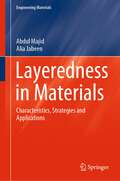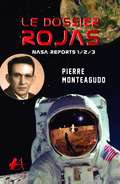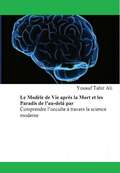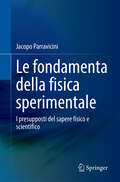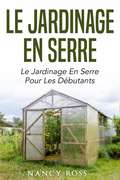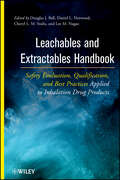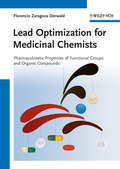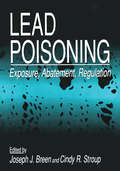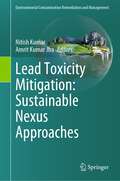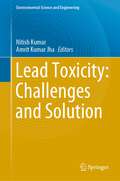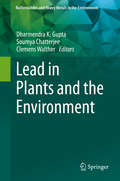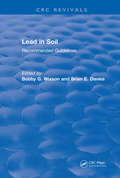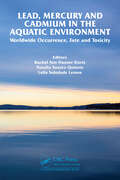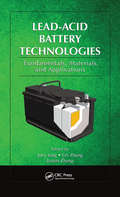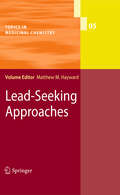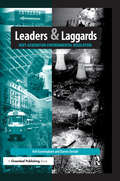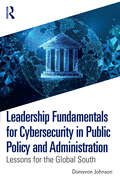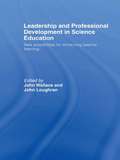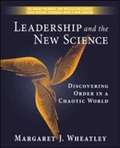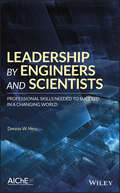- Table View
- List View
Layeredness in Materials: Characteristics, Strategies and Applications (Engineering Materials)
by Abdul Majid Alia JabeenThis book provides information on the characteristics, strategies and applications of layered materials. It sheds light on layerdness-dependent properties of Van der Waals solids for potential applications. The properties of various layered materials prepared using different experimental strategies are described. Further, the first-principles calculations are given to devise a strategy to investigate layeredness in materials. The structural, thermal, mechanical, lattice vibronic, electronic, optical and carrier transport characteristics of the layered materials are elaborated in detail. This book provides an updated source of information on layered materials for students, researchers, and professionals.
Laying the Foundation for Space Solar Power: An Assessment of NASA's Space Solar Power Investment Strategy
by Committee for the Assessment of NASA's Space Solar Power Investment StrategyInformation on Laying the Foundation for Space Solar Power
Lazare and Sadi Carnot
by Raffaele Pisano Charles C. GillispieLazare Carnot was the unique example in the history of science of someone who inadvertently owed the scientific recognition he eventually achieved to earlier political prominence. He and his son Sadi produced work that derived from their training as engineering and went largely unnoticed by physicists for a generation or more, even though their respective work introduced concepts that proved fundamental when taken up later by other hands. There was, moreover, a filial as well as substantive relation between the work of father and son. Sadi applied to the functioning of heat engines the analysis that his father had developed in his study of the operation of ordinary machines. Specifically, Sadi's idea of a reversible process originated in the use his father made of geometric motions in the analysis of machines in general. This unique book shows how the two Carnots influenced each other in their work in the fields of mechanics and thermodynamics, and how future generations of scientists have further benefited from their work.
Le Dossier Rojas
by Luc Wyn Pierre MonteagudoDescription du livre: Mystères et secrets sont découverts depuis de 5 décennies dans une histoire passionnante qui révèle le complot pour masquer les inventions et les découvertes du docteur Rojas, un scientifique élémentaire pour le débarquement de l’homme sur la lune. Au milieu de la « Guerre Froide », en travaillant pour le NASA, le docteur Rojas s'est réuni avec un président, voyageait á l’ancienne Union Soviétique, prenait la décision fatidique de se rendre á un entrevue á Washington D.C. y depuis, qu'est-ce qui se passait? Les entités impliquées disent que ne savent rien de lui, mais la vérité est cette histoire basée sur la réalité. Quand se rapproche le 50ième anniversaire du premier débarquement d’une équipe sur la lune, nous nous rencontrons avec ce livre fascinant, qui consiste de deux parties. Dans la première, on présente un hommage à la mémoire posthume de l’astrophysicien Héctor R. Rojas, qui pouvait voyager à la lune dans des vols secrets du NASA. Dans la deuxième partie, l’auteur donne ses pensées de toute une vie concernant le phénomène OVNI. Sans doute, il s'agit d’une histoire passionnante écrite dans une langue simple et directe.
Le Modèle de Vie après la Mort et les Paradis de l’au-delà: Comprendre l'occulte par l'usage de la science moderne
by Yousuf Tahir AliL’auteur mène une discussion sur les écritures religieuses notamment l’islam qui se sont révélées vrais au fil de temps. Dans ce contexte il essai de prouver la véracité de telles écritures á partir de l’usage de la science moderne. Pour en arriver á son but, l’auteur fait recours á la science physique d’Einstein (Théorie de relativité) et de Stephen Hawking pour comprendre la vie après la mort en plus d’autres aspects occultes en particulier l’âme et l’esprit. En bref l’œuvre et un mélange de théologie et science que l’auteur essai á les marier en vue d’avoir une confirmation sur une vie éventuelle de l’au-delà.
Le Verrier—Magnificent and Detestable Astronomer
by James LequeuxTranslated from the original French by Bernard Sheehan; Edited and with an introduction by Dr. William Sheehan, a neuroscientist and amateur astronomer who is also a research fellow of the Lowell Observatory in Flagstaff, Arizona Le Verrier was a superb scientist. His discovery of Neptune in 1846 made him the most famous astronomer of his time. He produced a complete theory of the motions of the planets which served as a basis for planetary ephemeris for a full century. Doing this, he discovered an anomaly in the motion of Mercury which later became the first proof of General Relativity. He also founded European meteorology. However his arrogance and bad temper created many enemies, and he was even fired from his position of Director of the Paris Observatory.
Le fondamenta della fisica sperimentale: I presupposti del sapere fisico e scientifico
by Jacopo ParraviciniQuesto libro ha lo scopo di fornire un’ampia riflessione sui principi generali della fisica e gli elementi fondanti della conoscenza scientifica nella loro unitarietà. Sfruttando largamente il pensiero di molti tra i più grandi scienziati, esso offre una chiara comprensione dei fondamenti della fisica e del suo metodo sperimentale, ponendo in risalto le correlazioni tra i principali eterogenei elementi che vi stanno alla base. Si ricorda come le scienze sperimentali non siano statiche ma, al contrario, soggette a continui studi e ripensamenti. Nell'affrontare la mancanza di lezioni o trattazioni sistematiche sulla natura del metodo scientifico nei tradizionali corsi universitari tecnico-scientifici, l'autore si addentra così nello studio di ciò che sta alla base della scienza in generale, e della fisica in particolare. Sono trattati temi quali la relazione tra fenomeni naturali e il linguaggio matematico, mettendo in risalto i principali snodi dello sviluppo concettuale nella scienza. Inoltre l’autore discute l’importanza della “pratica scientifica” sottolineandone il ruolo nell’avanzamento della conoscenza scientifica, e il modo con cui essa contribuisce alla fisica nel suo complesso. Il libro è suddiviso in tre parti, ciascuna delle quali copre differenti aspetti della fisica e dei suoi fondamenti: la prima parte riguarda le radici fenomenologiche e gli strumenti basilari della disciplina; la seconda si concentra sulla struttura della conoscenza scientifica; la terza tratta i metodi pratici dell’indagine scientifica. Il libro rimane accessibile per qualsiasi studente di discipline tecnico-scientifiche, poiché un non fisico sarà agevolmente in grado di trovare facilmente in libri di testo di natura introduttiva spiegazioni di quei concetti fondamentali dati per assodati.
Le jardinage en serre: Le jardinage en serre pour les débutants
by Nancy Ross Gaulthier MarrelVOULEZ-VOUS DECOUVRIR LES TENANTS ET ABOUTISSANT DU JARDINAGE EN SERRE ? Voici un aperçu de ce que vous apprendrez... Installer un potager dans une serre Cultiver des plantes dans votre serre Manières de contrôler le climat dans la serre Certains des meilleures méthodes de plantation dans la serre Comment se débarrasser des insectes nuisibles Et bien plus encore !
Le mal d'Alzheimer III
by Juan Moisés de la SernaComment traite-t-on la maladie d’Alzheimer ? Quelle est son évolution ? Comment peut-on prévenir son évolution ? Apprenez au sujet des dernières avancées en termes de prévention et de traitement de la maladie d’Alzheimer. Un des aspects les plus importants d’une maladie est de savoir comment la vaincre, si elle dispose d’un remède et quel est le traitement. A ce sujet, de nombreux progrès sont réalisés en permanence dans le domaine de la recherche de traitement et de prévention de la maladie d’Alzheimer, comme nous les présenterons dans cet écrit. Objectif : L’objectif du livre est de servir de première approche à toute personne touchée de près ou de loin par la maladie d’Alzheimer, qu’elle soit elle-même la personne malade ou qu’il s’agisse d’un proche. Ce livre cherche à présenter de façon claire les résultats des dernières recherches sur la maladie d’Alzheimer, dans le but de répondre aux questions les plus pertinentes : comment se traite cette maladie ? quelle est son évolution ? comment se prévient-elle ? Destinataires : Professionnels de santé qui doivent approfondir leurs connaissances en termes de diagnostic et de traitement de la maladie d’Alzheimer. Professeurs qui souhaitent fournir une information actualisée à leurs élèves sur la maladie d’Alzheimer. Tous ceux qui ont été diagnostiqués de la maladie d’Alzheimer et leurs proches afin de savoir que faire face à cette maladie Thématique Ci-dessous, voici le détail de chacune des thématiques principales de cette ouvrage : Traitement de l’Alzheimer : malgré les limites des traitements actuels, de nouvelles découvertes sont réalisées chaque jour afin de faire face à cette maladie Évolution de l’Alzheimer : la maladie d’Alzheimer se définit comme une maladie progressive, c’est-à-dire qu’avec le temps, elle provoque la perte des capacités co
Leachables and Extractables Handbook
by Douglas J. Ball Cheryl L. Stults Daniel L. Norwood Lee M. NagaoA practical and science-based approach for addressing toxicological concerns related to leachables and extractables associated with inhalation drug productsPackaging and device components of Orally Inhaled and Nasal Drug Products (OINDP)-such as metered dose inhalers, dry powder inhalers, and nasal sprays-pose potential safety risks from leachables and extractables, chemicals that can be released or migrate from these components into the drug product. Addressing the concepts, background, historical use, and development of safety thresholds and their utility for qualifying leachables and extractables in OINDP, the Leachables and Extractables Handbook takes a practical approach to familiarize readers with the recent recommendations for safety and risk assessment established through a joint effort of scientists from the FDA, academia, and industry. Coverage includes best practices for the chemical evaluation and management of leachables and extractables throughout the pharmaceutical product life cycle, as well as: Guidance for pharmaceutical professionals to qualify and risk-assess container closure system leachables and extractables in drug products Principles for defining toxicological safety thresholds that are applicable to OINDP and potentially applicable to other drug products Regulatory perspectives, along with an appendix of key terms and definitions, case studies, and sample protocolsAnalytical chemists, packaging and device engineers, formulation development scientists, component suppliers, regulatory affairs specialists, and toxicologists will all benefit from the wealth of information offered in this important text.
Lead Optimization for Medicinal Chemists
by Florencio Zaragoza DörwaldSmall structural modifications can significantly affect the pharmacokinetic properties of drug candidates. This book, written by a medicinal chemist for medicinal chemists, is a comprehensive guide to the pharmacokinetic impact of functional groups, the pharmacokinetic optimization of drug leads, and an exhaustive collection of pharmacokinetic data, arranged according to the structure of the drug, not its target or indication. The historical origins of most drug classes and general aspects of modern drug discovery and development are also discussed. The index contains all the drug names and synonyms to facilitate the location of any drug or functional group in the book.This compact working guide provides a wealth of information on the ways small structural modifications affect the pharmacokinetic properties of organic compounds, and offers plentiful, fact-based inspiration for the development of new drugs. This book is mainly aimed at medicinal chemists, but may also be of interest to graduate students in chemical or pharmaceutical sciences, preparing themselves for a job in the pharmaceutical industry, and to healthcare professionals in need of pharmacokinetic data.
Lead Poisoning: Exposure, Abatement, Regulation
by Joseph J. Breen Cindy R. StroupLead Poisoning discusses one of the most critical and preventable environmentally induced illnesses. The actual toll lead poisoning takes on society cannot be measured fully due to the "silent" nature of health effects, such as subtle intellectual deficits and neurological damage, caused by chronic low-level exposures. This book covers every major topic on the subject, including lead poisoning in children, sources of contamination, state-of-the-art sampling and analytical measurement methods, the newest studies on low-cost abatement methods, and much more. This reference is the most comprehensive presentation of issues currently available under one cover.The text is divided into three major parts. Part I provides insights from studies assessing lead exposures from paint, dust, soil, and lead battery recycling operations. The second part is a unique collection of strategic federal policy statements from the U.S. EPA, HUD, and HEW-CDC. It details the National Implementation Plan as well as a local government's efforts to provide low-cost effective risk communication and public outreach to the community. The next part offers seven chapters on analytical issues in the measurement of lead in blood, paint, dust, and soils. Part IV, Sampling Methods and Statistical Issues, rounds out the technical portion of the volume. The relationships among lead levels in biological and environmental media are investigated and the interpretive problems discussed. The use of multi-element analysis of environmental samples as an approach to investigate sources is described.The book finishes with its most unique feature-OPPT's Check Our Kids for Lead Program, one organization's effort to empower its employees to make a personal difference in confronting the problem of lead poisoning in children. The Program serves as a model for other government organizations (federal, state, and local), university and community organizations, and corporations to educate them and take personal and corporate responsibility for addressing this important and environmental health problem.
Lead Toxicity Mitigation: Sustainable Nexus Approaches (Environmental Contamination Remediation and Management)
by Nitish Kumar Amrit Kumar JhaThis edited book brings together a diverse group of researchers to address the challenges posed by global mass poisoning caused by lead contamination of soil and plants. Lead is among the elements that have been most extensively used by man over time. This has led to extensive pollution of surface soils on the local scale, mainly associated with mining and smelting of the metal and addition of organic lead compounds to petrol. Release of lead to the atmosphere from various high-temperature processes has led to surface contamination on the regional and even global scale. Lead is particularly strongly bound to humic matter in organic-rich soil and to iron oxides in mineral soil and is rather immobile in the soil unless present at very high concentrations. In addition, plants grown on lead-rich soils incorporate lead and thus the concentration of lead in crop plants may be increased. Lead enters in the food chain through consumption of plant material. A high concentration of lead has been found to be harmful to vegetation. As the lead concentration increases, it adversely affects several biological parameters and eventually renders the soil barren. The book sheds light on this global environmental issue and proposes solutions to contamination through multi-disciplinary approaches. This book contains three sections. First section describes the different sources and distribution of lead in soil and plant ecosystems. Second section explains the health risks linked to lead toxicity. Third section addresses sustainable lead toxicity mitigation strategies using the potential applications of recent biological technology. This book is a valuable resource to students, academics, researchers, and environmental professionals doing field work on contamination throughout the world.
Lead Toxicity: Challenges and Solution (Environmental Science and Engineering)
by Nitish Kumar Amrit Kumar JhaThis book delivers an outline to graduate, undergraduate students, and researchers, as well as academicians who are working on lead toxicity with respect to remediation. It covers sources of lead contamination and its impact on human health and on prospective remediation through multi-disciplinary approaches with application of recent advanced biological technology. Lead is among the elements that have been most extensively used by man over time. This has led to extensive pollution of surface soils on the local scale, mainly associated with mining and smelting of the metal and addition of organic lead compounds to petrol. Release of lead to the atmosphere from various high-temperature processes has led to surface contamination on the regional and even global scale. In addition, plants grown on lead-rich soils incorporate lead, and thus, the concentration of lead in crop plants may be increased. Lead enters in the food chain through consumption of plant material. A high concentration of lead has been found to be harmful to vegetation. As the lead concentration increases, it adversely affects several biological parameters and eventually renders the soil barren. This edited book brings together a diverse group of researchers to address the challenges posed by global mass poisoning caused by lead contamination of soil and plants. The book sheds light on this global environmental issue and proposes solutions to contamination through multi-disciplinary approaches. This book contains three sections. The first section describes the different sources and distribution of lead in soil and plant ecosystems. The second section explains the health risks linked to lead toxicity. The third section addresses sustainable lead toxicity mitigation strategies and the potential applications of recent biological technology in providing solutions. This book is a valuable resource to students, academics, researchers, and environmental professionals doing fieldwork on lead contamination throughout the world.
Lead in Plants and the Environment (Radionuclides and Heavy Metals in the Environment)
by Dharmendra K. Gupta Clemens Walther Soumya ChatterjeeThis book examines the way that lead enters the biosphere and the subsequent environmental impact. The contributing authors include international experts who provide methods for assessing and characterizing the ecological risk of lead contamination of soil and plants. Information is provided on the consequences for human health as a result of lead pollution. This book reveals that approximately 98% of stable lead in the atmosphere originates from human activities.Lead in Plants and the Environment reports on methods for detecting, measuring, and assessing the concentration of lead in plants. The authors provide a method for the measurement of 210Pb isotopes in plants. This method can be applied extensively in different environmental settings, not only as a way of revealing sources of lead, but also as a way to monitor lead transport in plants and animals that ingest them.The chapters include coverage on the following topics:· Lead bioavailability in the environment and its exposure and effects· Radioanalytical methods for detecting and identifying trace concentrations of lead in the environment· Lead contamination and its dynamics in soil plant systems· Lead pollution monitoring and remediation through terrestrial plants in mesocosm constructed wetlands· A review of phytoremediation of leadThis book is a valuable resource to students, academics, researchers, and environmental professionals doing field work on lead contamination throughout the world.
Lead in Soil: Recommended Guidelines (CRC Press Revivals)
by Bobby G. Wixson Brian E. Davies Robert L. BornscheinUntil the publication of this new book there had been a lack of well-founded guidelines for evaluating concentrations of lead in soil and its relationship to human health. Thus, much confusion has existed among regulatory agencies, industries, public health officials, and the medical community about the evaluation and remedying of lead-contaminated soils.Lead in Soil: Recommended Guidelines represents the combined efforts of a multi-disciplinary international task force from the Society for Environmental Geochemistry and Health (SEGH) whose members are experts in the fields of lead pollution and toxicology. It provides an international consensus concerning environmental lead and blood lead-especially in children.The task force evaluated the evidence and made recommendations for guidelines to appraise lead concentration. It also studied the influence of soil and other sources of lead on blood lead concentrations. A model was prepared that allows the user to select appropriate target levels of blood lead while allowing for a variety of environmental situations or regulatory criteria.
Lead, Mercury and Cadmium in the Aquatic Environment: Worldwide Occurrence, Fate and Toxicity
by Rachel Ann Hauser-Davis Natalia Soares Quinete Leila Soledade LemosThis book presents an integrated and holistic discussion on cadmium, lead and mercury toxicity in aquatic environments, expanding general concepts on chemical speciation effects and exploring specific environmental toxicological issues, exposure routes, and bioanalytical approaches for their determination and assessments on their intracellular deleterious effects. It contains worldwide and regional aspects on cadmium, lead and mercury occurrence, fate, and toxicity, addressing key environmental exposure and health risk concerns to both humans and aquatic organisms. Our book is of interest to anyone conducting research in the broad fields of oceanography, geochemistry, ecotoxicology, and environmental and public health.
Lead-Acid Battery Technologies: Fundamentals, Materials, and Applications (Electrochemical Energy Storage and Conversion)
by Lei Zhang Jiujun Zhang Joey JungLead-Acid Battery Technologies: Fundamentals, Materials, and Applications offers a systematic and state-of-the-art overview of the materials, system design, and related issues for the development of lead-acid rechargeable battery technologies. Featuring contributions from leading scientists and engineers in industry and academia, this book:Describe
Lead-Seeking Approaches
by Matthew M. HaywardChristopher A. Lipinski: Overview of hit to lead: the medicinal chemistâ__s role from HTS retest to lead optimization hand offJeff W. Paslay â_¢ John E. Morin â_¢ Richard K. Harrison: High Throughput Screening in the 21st CenturyJack Andrew Bikker â_¢ Lakshmi S. Narasimhan: Lead Discovery Using Virtual Screening Maurizio Pellecchia: NMR Spectroscopy in Fragment Based Drug DesignKevin D. Freeman-Cook â_¢ Daniel W. Kung: Hit Triage â__ Medicinal Chemistry Strategies to Improve the Odds of Success in DiscoveryJohn W. Ellingboe â_¢ Adam M. Gilbert: Lead Identification
Leaders and Laggards: Next-Generation Environmental Regulation
by Darren Sinclair Neil GunninghamConsensus is growing internationally that traditional command-and-control approaches to environmental regulation have borne much of their low-hanging fruit. Yet it is far from clear what should complement or replace them. Regulatory agencies and policy-makers are struggling with a lack of information about regulatory reform, about what works and what doesn't, and about how best to harness the resources of both government and non-government stakeholders. Progress is being impeded unnecessarily by a lack of shared knowledge of how similar agencies elsewhere are meeting similar challenges and by a lack of data on the success or otherwise of existing initiatives. Despite recent and valuable attempts to deal with such problems in the European Union and North America, these remain islands of wisdom in a sea of ignorance. For example, when it comes to dealing with small and medium-sized enterprises, very little is known, and what is known is not effectively distilled and disseminated. Much the same could be said about the roles of third parties, commercial and non-commercial, as surrogate regulators, and more broadly of many current initiatives to reconfigure the regulatory state. Based on the authors' work for the OECD, Victorian Environmental Protection Authority and the Western Australian Department of Environment Protection, Leaders and Laggards addresses these problems by identifying innovative regulatory best practice internationally in a number of specific contexts, evaluating empirically the effectiveness of regulatory reform and providing policy prescriptions that would better enable agencies to fulfil their regulatory missions. Focusing primarily on the differing requirements for both corporations and small and medium-sized enterprises in North America and Europe, the book aims to complement existing initiatives and to expand knowledge of regulatory reform by showing: how existing experience can best be put to practical use "on the ground"; by drawing lessons from experiments in innovative regulation internationally; by reporting and extrapolating on original case studies; and by advancing understanding on which instruments and strategies are likely to be of most value and why. The authors argue that the development of theory has outstripped its application. In essence, Leaders and Laggards aims to ground a myriad of theory on the reinvention of environmental regulation into practice. The book will be essential reading for environmental policy-makers, regulatory and other government officials responsible for policy design and implementation, academics and postgraduate students in environmental management, environmental law and environmental policy, and a more general readership within environmental policy and management studies. It will also be of interest to those in industry, such as environmental managers and corporate strategists, who are considering the use of more innovative environmental and regulatory strategies, and to environmental NGOs.
Leadership Fundamentals for Cybersecurity in Public Policy and Administration: Lessons for the Global South
by Donavon JohnsonIn an increasingly interconnected and digital world, this book provides comprehensive guidance on cybersecurity leadership specifically tailored to the context of public policy and administration in the Global South.Author Donavon Johnson examines a number of important themes, including the key cybersecurity threats and risks faced by public policy and administration, the role of leadership in addressing cybersecurity challenges and fostering a culture of cybersecurity, effective cybersecurity governance structures and policies, building cybersecurity capabilities and a skilled workforce, developing incident response and recovery mechanisms in the face of cyber threats, and addressing privacy and data protection concerns in public policy and administration. Showcasing case studies and best practices from successful cybersecurity leadership initiatives in the Global South, readers will gain a more refined understanding of the symbiotic relationship between cybersecurity and public policy, democracy, and governance. This book will be of keen interest to students of public administration and public policy, as well as those professionally involved in the provision of public technology around the globe.
Leadership and Professional Development in Science Education: New Possibilities for Enhancing Teacher Learning
by John Wallace John LoughranLeadership and Professional Development in Science Education provides invaluable insight into the role of science teachers as learners and thinkers of change processes. The fourteen chapters, by an eminent international team of science educators, explain and explore the relationship between professional development, teacher leadership and teacher learning. Research-based practical and theoretical exemplars reflect state of the art science teacher leadership in a broad range of international contexts.The book is divided into three parts, reflecting a multi-layered approach to teacher learning:* Personal initiatives in teacher learning, focusing on individual teachers;* Collegial initiatives in teacher learning, focusing on groups of teachers;* Systemic initiatives for teacher learning, focusing on system-wide issues.Student teachers and practising teachers will find the text highly valuable as they consider and review the challenges of teaching practice and ways of working with colleagues, while school leaders and policymakers will benefit from the book's insight into system-wide issues of professional development.
Leadership and the New Science
by Margaret J. WheatleyThe author believes that organizations of all sizes need to recognize that traditional, unbending organizational structures are not equipped to deal with today's chaotic world. The answer lies in the "new science" Quantum Physics.
Leadership and the New Science: Discovering Order in a Chaotic World
by Margaret J. WheatleyThe new edition of the bestselling, acclaimed, and influential guide to applying the new science to organizations and management. In this new edition, Margaret Wheatley describes how the new science radically alters our understanding of the world and how it can teach us to live and work well together in these chaotic times. We live in a time of chaos, rich in potential for new possibilities. A new world is being born. We need new ideas, new ways of seeing, and new relationships to help us now. New science—the new discoveries in biology, chaos theory, and quantum physics that are changing our understanding of how the world works—offers this guidance. It describes a world where chaos is natural, where order exists "for free." It displays the intricate webs of cooperation that connect us. It assures us that life seeks order, but uses messes to get there. This book will teach you how to move with greater certainty and easier grace into the new forms of organizations and communities that are taking shape. You'll learn that: • Relationships are what matters—even at the subatomic level• Life is a vast web of interconnections where cooperation and participation are required• Chaos and change are the only route to transformation In this expanded edition, Wheatley provides examples of how non-linear networks and self-organizing systems are flourishing in the modern world. In the midst of turbulence, Wheatley shows, we create work and lives rich in meaning.
Leadership by Engineers and Scientists: Professional Skills Needed to Succeed in a Changing World
by Dennis W. HessTeaches scientists and engineers leadership skills and problem solving to facilitate management of team members, faculty, and staff This textbook introduces readers to open-ended problems focused on interactions between technical and nontechnical colleagues, bosses, and subordinates. It does this through mini case studies that illustrate scenarios where simple, clear, or exact solutions are not evident. By offering examples of dilemmas in technical leadership along with selected analyses of possible ways to address or consider such issues, aspiring or current leaders are made aware of the types of problems they may encounter. This situational approach also allows the development of methodologies to address these issues as well as future variations or new issues that may arise. Leadership by Engineers and Scientists guides and facilitates approaches to solving leadership/people problems encountered by technically trained individuals. Students and practicing engineers will learn leadership by being asked to consider specific situations, debate how to deal with these issues, and then make decisions based on what they have learned. Readers will learn technical leadership fundamentals; ethics and professionalism; time management; building trust and credibility; risk taking; leadership through questions; creating a vision; team building and teamwork; running an effective meeting; conflict management and resolution; communication; and presenting difficult messages. Leadership by Engineers and Scientists is an excellent text for technically trained individuals who are considering, anticipating, or have recently been promoted to formal leadership positions in industry or academia.
